SEPTEMBER 21, 22 PICTURE ALBUM
Sunday September 21 and Monday September 22
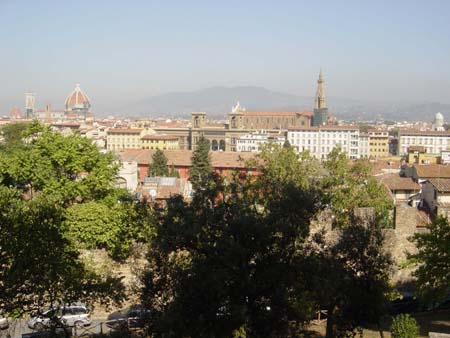
Steve: Sunday was our final day of relaxation here at Ponte a Bozzone before three full days we have planned in Florence, Montalcino, Pienza and Montepulciano. We preferred not to jam these together, but this is how the schedule worked for the guides that we've hired. Sunday was spent on schoolwork, trip planning and relaxing outside (the weather continues to be perfect). We also took a drive to Castelnuovo Berardenga, a town east of here that actually is one of the larger communities of the Chianti region. As we walked through the town center, I had the feeling that people were following their well-established daily routines. I imagined that they probably sit on the same benches, meet the same people and talk about the same things every evening. It was a relaxed, friendly atmosphere - the people here seem to have comfortable and very social lives.
Today we spent another day in Florence. We had arranged to hire Freya (who
we had met last week on our group tour) on a private basis to help us further
understand Florence's history, art and architecture. Freya has a wonderful
passion for Florence and a great knowledge of the Renaissance - her style
is also very engaging, and is perfect for what we are trying to accomplish
educationally. The drive into the city was easier (no wrong turns!), but the
traffic still amazes us - especially the #&%* scooters that dart around
like mosquitoes…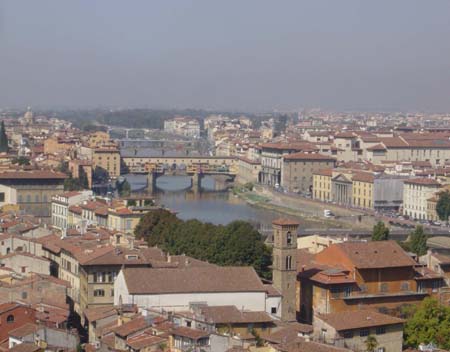
We decided today to mix some of Florence's more heavily visited sites with several "off-the-beaten-path" destinations and routes that Freya recommended. This turned out to be a perfect combination, and we all learned a tremendous amount. We started at the Pitti Palace, and learned how the Medici family purchased it from the Pitti's in 1548 when the Pitti's went bankrupt (this was ironic since the Pittis had specifically been building the palace to outrival the Medici's and their existing palace in the city center). The Medicis added significantly to the palace, including an obtrusive private corridor that led all the way across the river and to their personal offices (now the Uffizi). We learned about how this corridor became the Medici's personal walkway from the Palace into the city of Florence, and saw how it was built right across the facades of existing homes and churches (and right through the middle of several buildings). Freya told us several fascinating stories about how the Medicis used the Palace and its corridor as part of their rule of Florence. We plan to visit the inside of the Pitti Palace on Wednesday.
We visited the church of Santa Felicita, and the interesting Capponi family chapel inside. There are members of the Capponi family still living in Florence today (more on that later), and this remains their personal family chapel. The chapel contains Mannerist masterpieces by Pontormo from the 1500's. Mannerists are noted for their use of exaggerated colors and poses - these frescoes are perfect examples of this style.
Freya then took us on a fascinating walk along via di San Niccolo. Located
across the Arno River from the center of Florence, this was long considered
the "poor" area of Florence. Today, it has become one of Florence's
most desired locations to live. San Niccolo is lined with family palaces,
including one where members of the Capponi family still live (we were able
to see their names on the doorbells). The reason for these palaces being here
is very interesting. When families were exiled from Florence, this meant that
they simply were not able to live within the limits of the city walls. They
were still allowed to work and function in Florence. San Niccolo originally
fell just outside the city, so this was a perfect location for wealthy families
to establish large residences that could be used over the years as havens
for times when they had been exiled.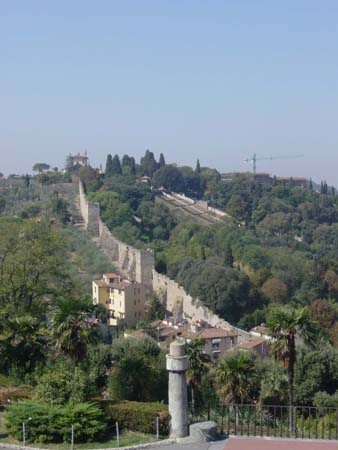
Along San Niccolo, we were also able to see several of Florence's tradesmen at work, functioning similarly to how they did in the 1400's and 1500's. We saw furniture makers in their shops, with large glass windows so that people can see inside. There are no signs or advertisements (they're not necessary) - business is done entirely by word of mouth, and these craftsmen are booked for years.
We walked through Porta Niccolo, one of Florence's original gates. There
was originally a wall around Florence, but only a small part remains. Gates
such as the one at Porta Niccolo were closed at night, and during the day
all entrances to the city were carefully monitored. This is where the word
"passport" originates (passing through a door) and a primary objective
of gates such as these was trying to control the spread of the black plague.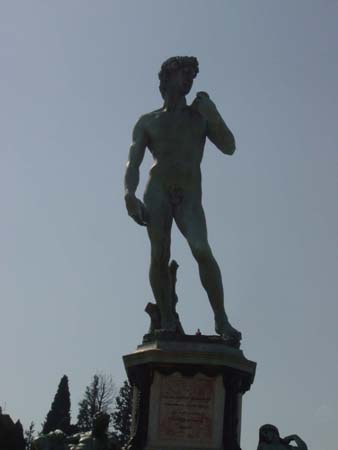
From Porta Niccolo we walked up to Piazza Michelangelo, which was built in the 1800's by Giuseppe Poggi as part of his effort to turn Florence into a true capital for Italy. The Piazza provides wonderful views across all of Florence, and Freya was able to give us an excellent perspective on how Florence has grown through the years. It was also interesting to see and understand the surrounding areas, and the dynamics of Florence's location. We learned that Florence is actually the hottest city in Italy, since it is surrounded by hills and receives very little wind. On the Piazza Michelangelo is the second copy of Michelangelo's David - it's surrounded by tourist shops and a large parking lot, and looks very out of place.
We continued our climb toward San Miniato al Monte, a fantastic Benedictine
church and monastery with a wonderful view over Florence. Freya said that
San Miniato is considered to be one of Florenece's finest churches, but is
rarely visited by tourists because it's harder to get to. She explained that
the Benedictines always built their churches outside the city (compared with
the Franciscans and 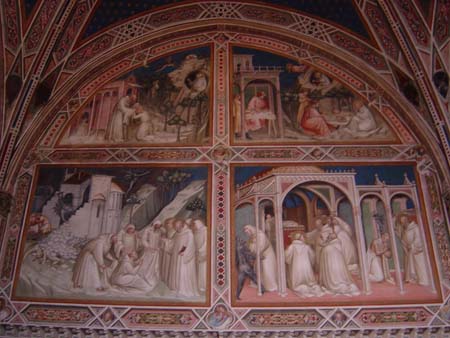 Dominicans
whose churches are always within the city). San Miniato is one of the oldest
churches in Florence, and has an amazing mix of art from the 1300's. It also
contains a mysterious collection of geometric symbols and zodiac signs, many
of which are not fully understood today. We especially enjoyed learning about
the frescoes painted in the 1300's by Spinello Aretino. They each tell a different
story about Benedict's life, and flow left-to-right as individual stories.
It was also fascinating to see the crypt of St. San Miniato. Legend has it
that San Miniato was beheaded in Florence in the third century for his religious
convictions, and then carried his own head up to this spot (which is why the
church was established here).
Dominicans
whose churches are always within the city). San Miniato is one of the oldest
churches in Florence, and has an amazing mix of art from the 1300's. It also
contains a mysterious collection of geometric symbols and zodiac signs, many
of which are not fully understood today. We especially enjoyed learning about
the frescoes painted in the 1300's by Spinello Aretino. They each tell a different
story about Benedict's life, and flow left-to-right as individual stories.
It was also fascinating to see the crypt of St. San Miniato. Legend has it
that San Miniato was beheaded in Florence in the third century for his religious
convictions, and then carried his own head up to this spot (which is why the
church was established here).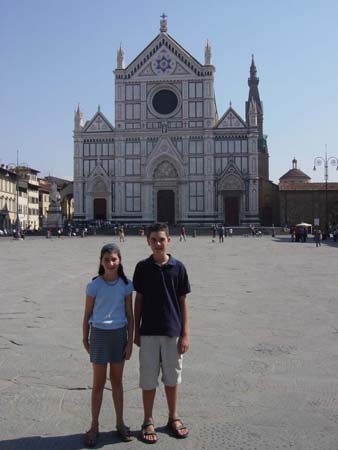
We walked back into Florence and visited Santa Croce, considered by many
Florentines to be their favorite church. Santa Croce has its own beautiful
Piazza, lined with wonderful Renaissance buildings (some with original frescoes
still visible). Freya showed us how the Renaissance architecture was designed
very precisely, mirroring many of the scientific characteristics of the human
body. The Santa Croce church itself has a very large and warm feeling to it
- Franciscan churches are generally open and airy, and are designed to create
a friendly and social atmosphere. In the 1500's, Giorgio Vasari completely
whitewashed the walls of Santa Croce, and designed his own system of alternating
frescoes (all painted by him and his school) and tombs. The tombs of several
famous Florentines are here, including Michelangelo and Galileo. There are
several family chapels in the front of Santa Croce, all painted with famous
frescoes by Giotti. Giotti was considered to be the master of frescoes during
1300's, and it was interesting hearing the stories about how these had been
whitewashed,  then
partially re-painted, and finally restored to their current states. We also
enjoyed visiting Santa Croce's Baroncelli Chapel, and seeing its frescoes
by Gaddi.
then
partially re-painted, and finally restored to their current states. We also
enjoyed visiting Santa Croce's Baroncelli Chapel, and seeing its frescoes
by Gaddi.
Part of the fun today was learning the stories told in the great works of
art as well as the political story surrounding each piece of art. We learned
about how the Renaissance period and how its art represented a rediscovery
of humanism following the Dark Ages including the contributions of ancient
Greek and Roman society. We learned abo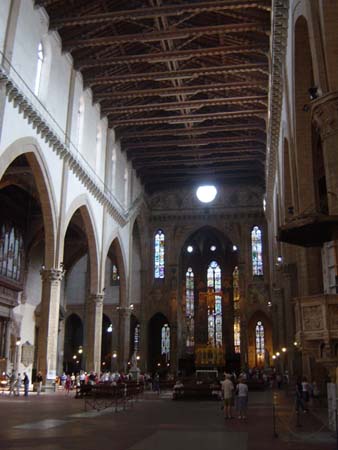 ut
coats of arms and religious symbols (for example St. Mark always is seen with
a winged lion, St. Matthew with an angel, St. John with an eagle and St. Luke
with an ox) and then had fun searching for these in the art work and architecture
we saw throughout the day. Freya taught us about unique characteristics of
Florentine architecture, such as the ubiquitous "beggar doors" that
appear on family palaces (these were used for handouts, and are the origin
for the phrase "hole in the wall").
ut
coats of arms and religious symbols (for example St. Mark always is seen with
a winged lion, St. Matthew with an angel, St. John with an eagle and St. Luke
with an ox) and then had fun searching for these in the art work and architecture
we saw throughout the day. Freya taught us about unique characteristics of
Florentine architecture, such as the ubiquitous "beggar doors" that
appear on family palaces (these were used for handouts, and are the origin
for the phrase "hole in the wall").
Although most of Florence's museums are dedicated to art, we had heard about
its science museum and its wonderful collection mathematical, astronomical
and medical instruments. The museum was great, and a nice change of pace from
all the art we had 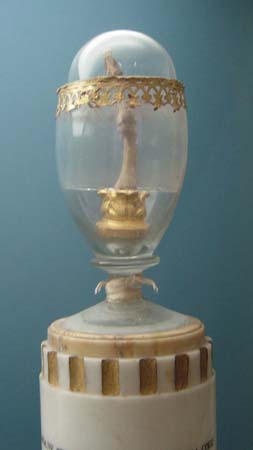 seen
today. We especially enjoyed seeing Galileo's telescopes (and also an embalmed
finger from his right hand - it's pictured here). The beauty and quality of
the instruments in the museum is really amazing, especially considering that
these were all produced by hand.
seen
today. We especially enjoyed seeing Galileo's telescopes (and also an embalmed
finger from his right hand - it's pictured here). The beauty and quality of
the instruments in the museum is really amazing, especially considering that
these were all produced by hand.
David's comment at the end of the day was "We spent the whole day seeing
art, but I was never bored!" Coming from David, who generally does not
enjoy seeing art, this was quite a statement…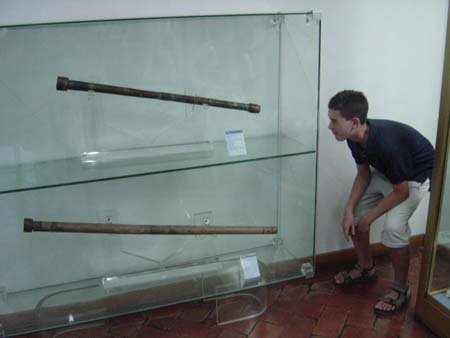
Our drive back from Florence was a long one - leaving the city took a full 45 minutes (more like a story from Boston or Chicago - not Florence!). Tomorrow we're planning a full-day trip with Roberta to Montalcino, Pienza and Montepulciano in the southern part of Tuscany.
Distance Walked: 6.04 miles
